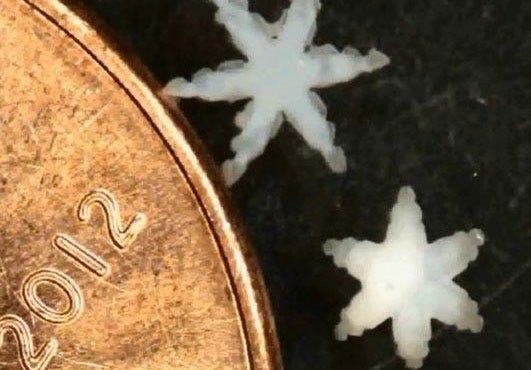Meet the Robots That Could Take on Biopsies, Drug Delivery, and More
February 7, 2015
Soft robotics, armed with tiny flexible grippers, could be used for scores of medical applications, including biopsies, drug-delivery, and diagnostics.
Kristopher Sturgis
|
Photo of the star-shaped grippers that could one day be used to take biopsies. |
Robotics have unquestionably revolutionized the manufacturing industry, yet their use in medicine has been fairly limited until recently. While robotics are now being used for applications like surgery and sterilizing hospitals, a new breed of small flexible robots could be leveraged for novel medical uses.
Known as "soft robotics," these instruments are made of hydrogels and are capable of reacting to changes in temperature, acidity, and light. These robotic designs are even specifically tailored to provide energy to carry out tasks without being anchored by a power source. Recently, researchers took these hydrogels a step further, combining them with a stiff biodegradable polymer to forge robotic star-shaped microhands that are strong enough to wrap around and remove cells, according a news release from the American Chemical Society.
The development could help doctors perform remotely guided surgical procedures and biopsies. The researchers even think the materials could eventually be used to deliver therapeutic drugs to hard-to-reach places in the body. The biggest advantage to the technology is the improved mobility, as most robotic tools require cords to power the device, tethering them and ultimately limiting their movements as well as the spaces they can access.
It was only recently that researchers were able to find a way to efficiently navigate such flexible robotics inside the body. They did this by fashioning the microhands with magnetic nanoparticles in the material, providing them with the ability to guide the microhands with a magnetic probe. They found that this added trait could help in the microassembly or microengineering of soft robotics and biological parts, as well as give surgeons the ability to remotely direct the removal of tissue samples for biopsies. Providing the grippers with mobility inside the body is what makes the discovery truly significant, providing doctors unprecedented access and reach inside the tiny nooks and crannies of the human body.
The soft robotic materials could be used as a building block for more efficient and adaptable biodegradable surgical tools that can safely dissolve naturally into the body.
The video below shows the grippers in action:
Refresh your medical device industry knowledge at MD&M West, in Anaheim, CA, February 10-12, 2015. |
Kristopher Sturgis is a contributor to Qmed and MPMN.
Like what you're reading? Subscribe to our daily e-newsletter.
About the Author(s)
You May Also Like


.png?width=300&auto=webp&quality=80&disable=upscale)
